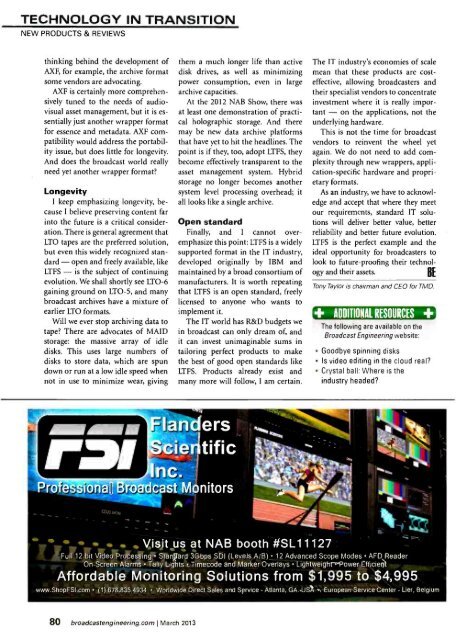ßroadcastEnsineerin - AmericanRadioHistory.Com
ßroadcastEnsineerin - AmericanRadioHistory.Com
ßroadcastEnsineerin - AmericanRadioHistory.Com
You also want an ePaper? Increase the reach of your titles
YUMPU automatically turns print PDFs into web optimized ePapers that Google loves.
TECHNOLOGY IN TRANSITION<br />
NEW PRODUCTS & REVIEWS<br />
thinking behind the development of<br />
AXF, for example, the archive format<br />
some vendors are advocating.<br />
AXF is certainly more comprehensively<br />
tuned to the needs of audiovisual<br />
asset management, but it is essentially<br />
just another wrapper format<br />
for essence and metadata. AXF compatibility<br />
would address the portability<br />
issue, but does little for longevity.<br />
And does the broadcast world really<br />
need yet another wrapper format?<br />
Longevity<br />
I keep emphasizing longevity, because<br />
I believe preserving content far<br />
into the future is a critical consideration.<br />
There is general agreement that<br />
LTO tapes are the preferred solution,<br />
but even this widely recognized standard<br />
- open and freely available, like<br />
LTFS - is the subject of continuing<br />
evolution. We shall shortly see LTO -6<br />
gaining ground on LTO -5, and many<br />
broadcast archives have a mixture of<br />
earlier LTO formats.<br />
Will we ever stop archiving data to<br />
tape? There are advocates of MAID<br />
storage: the massive array of idle<br />
disks. This uses large numbers of<br />
disks to store data, which are spun<br />
down or run at a low idle speed when<br />
not in use to minimize wear, giving<br />
them a much longer life than active<br />
disk drives, as well as minimizing<br />
power consumption, even in large<br />
archive capacities.<br />
At the 2012 NAB Show, there was<br />
at least one demonstration of practical<br />
holographic storage. And there<br />
may be new data archive platforms<br />
that have yet to hit the headlines. The<br />
point is if they, too, adopt LTFS, they<br />
become effectively transparent to the<br />
asset management system. Hybrid<br />
storage no longer becomes another<br />
system level processing overhead; it<br />
all looks like a single archive.<br />
Open standard<br />
Finally, and I cannot overemphasize<br />
this point: LTFS is a widely<br />
supported format in the IT industry,<br />
developed originally by IBM and<br />
maintained by a broad consortium of<br />
manufacturers. It is worth repeating<br />
that LTFS is an open standard, freely<br />
licensed to anyone who wants to<br />
implement it.<br />
The IT world has R &D budgets we<br />
in broadcast can only dream of, and<br />
it can invest unimaginable sums in<br />
tailoring perfect products to make<br />
the best of good open standards like<br />
LTFS. Products already exist and<br />
many more will follow, I am certain.<br />
The IT industry's economies of scale<br />
mean that these products are cost -<br />
effective, allowing broadcasters and<br />
their specialist vendors to concentrate<br />
investment where it is really important<br />
- on the applications, not the<br />
underlying hardware.<br />
This is not the time for broadcast<br />
vendors to reinvent the wheel yet<br />
again. We do not need to add complexity<br />
through new wrappers, application-<br />
specific hardware and proprietary<br />
formats.<br />
As an industry, we have to acknowledge<br />
and accept that where they meet<br />
our requirements, standard IT solutions<br />
will deliver better value, better<br />
reliability and better future evolution.<br />
LTFS is the perfect example and the<br />
ideal opportunity for broadcasters to<br />
look to future- proofing their technology<br />
and their assets.<br />
m<br />
Tony Taylor is chairman and CEO for TMD.<br />
+ ADDITIONAL RESOURCES +<br />
The following are available on the<br />
Broadcast Engineering website:<br />
Goodbye spinning disks<br />
Is video editing in the cloud real?<br />
Crystal ball: Where is the<br />
industry headed?<br />
(anders<br />
cier4ific<br />
nc.<br />
Professional Broadcast Monitors<br />
. ... Visit us at NAB booth #SL11127<br />
iikri Full 12 bit vtdeordIresfing Standard 3Gbps SDI (Levels A /B) 12 Advanced Scope Modes AFD Reader<br />
On- Screen Alarms Tally Lights Timecode and Marker Overlays Lightweight Power Efficient<br />
Affordable Monitoring Solutions from $1,995 to $4,995<br />
www.ShopFSl.com (1) 678.835.4934 Worldwide Direct Sales and Service - Atlanta. GA. USA European Service Center - Lier. Belgium<br />
80 broadcastengineering.com I March 2013
















